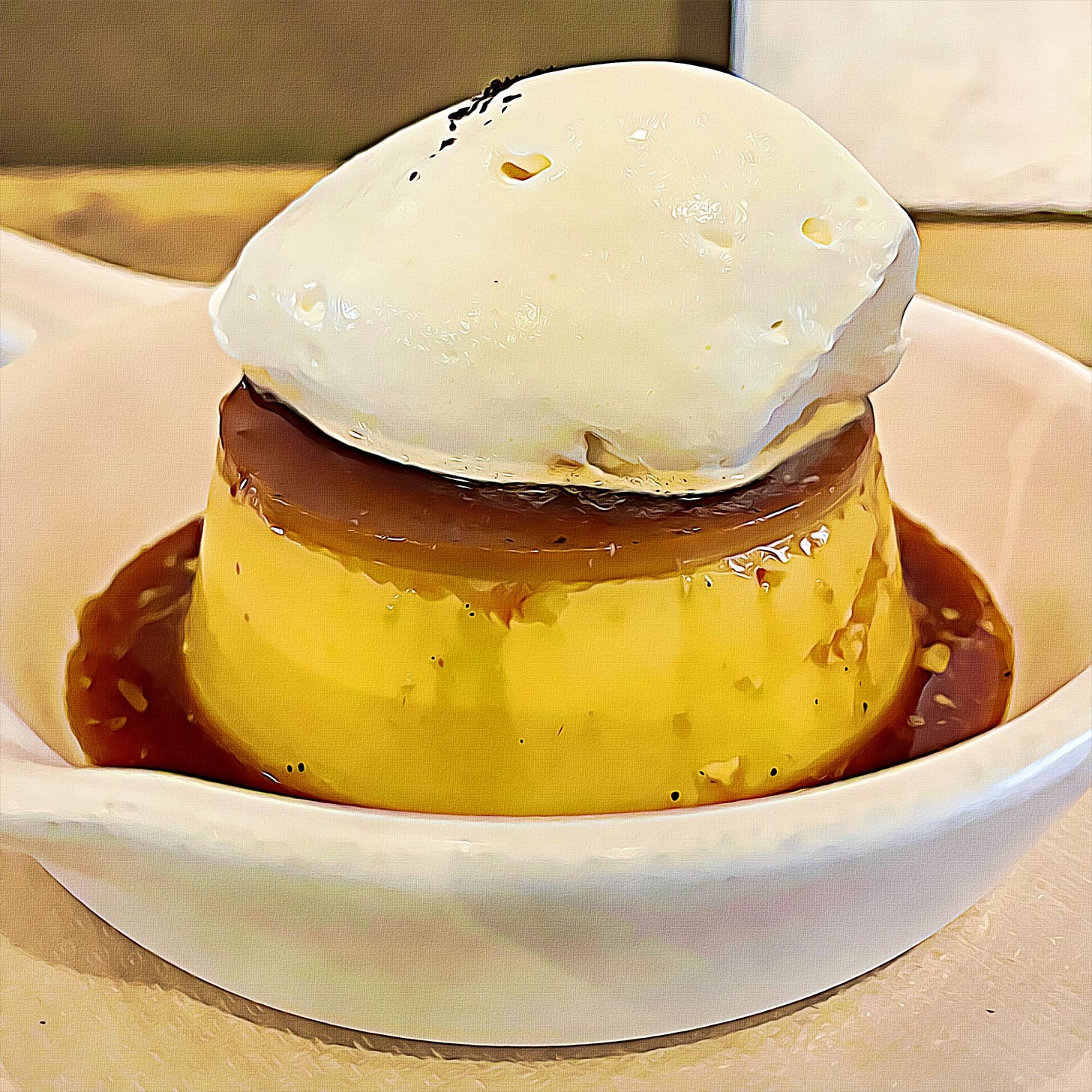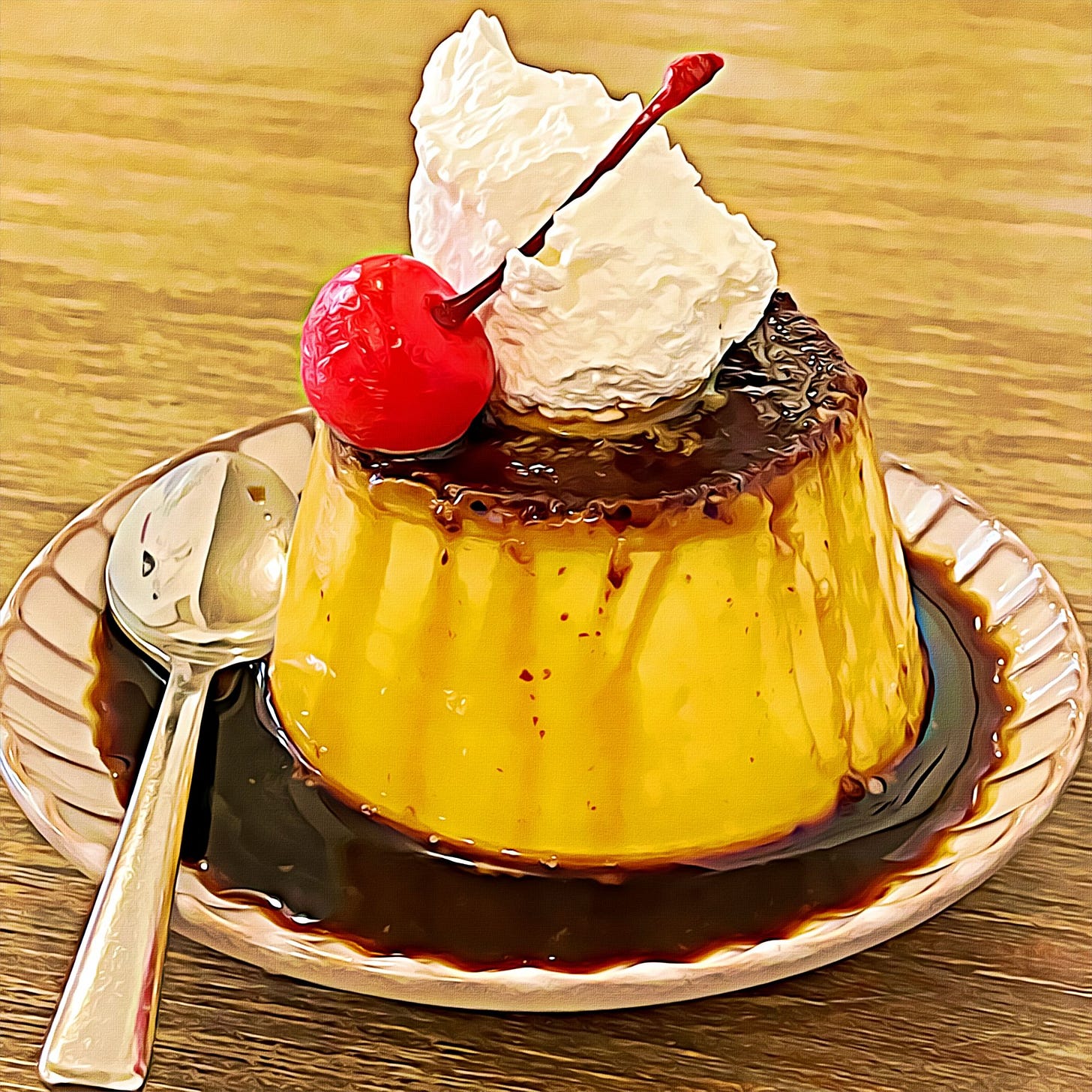The Joy of Jiggly Japanese Pudding
And where to find it in Tokyo.

Whenever I'm feeling tense and too tightly packed in the traffic and trains of Tokyo, there's only one thing that helps me loosen up: a wobbly, jiggly bowl of Japanese pudding (purin).
Some people might turn to meditation or yoga, but for me, it's all about the jiggle. There's something about that quivering, custardy goodness that just makes everything right in the world.
Some foods might not be acceptable to play with, but for pudding, I'd say it's highly recommended. Food is meant to be enjoyed and playing with it is a way to explore its textures, ingredients, and possibilities.
So there I was, several times during my stay in Japan exhausted and sometimes defeated in my travels, sitting in a cozy little coffee shop in Tokyo, staring down at a perfectly petite tea plate of Japanese pudding.
It was silky-smooth, creamy, and jiggly in all the right places.
There was a moat of rich syrup surrounding the gold, wide and wobbly tower topped with pure white whipped cream or mascarpone. It was a sight to behold and in both the real and imaginary world the attractiveness of the dessert was simply the cherry on top.
I felt afraid to ruin the sight but couldn't resist giving it a little poke with my spoon. Or in this case, it was a spoon-sized shovel with a flat edge to help slap, boing, then slice and scoop every last bit of the savory pudding from the plate.
My dilemmas were done as I sank into satisfaction and discovered the proof of the pudding.

You might be wondering, "Is flan the same as Japanese pudding? How did flan end up in Japan?"
The difference between Japanese pudding and flan might seem like they are just two variations on a jiggly custard theme to the uninitiated, but to a connoisseur of custards like myself, it's a distinction worth savoring.
Japanese pudding tends to be a bit more jiggly than your average flan, thanks to its use of a combination of milk and heavy cream. This gives it a lusciously creamy texture that practically dances on the tongue. Flan, on the other hand, is a bit more solid, with a denser consistency that still manages to be silky-smooth.
Up until now, we've been referring to Japanese pudding as so, but on menus and such, the actual language is "purin."
“Purin" for Japanese pudding has nothing to do with the sound it makes when you shake it, although it does have a certain ring to it.
Back in the early 1900s, when Western-style desserts like pudding and custard first started becoming popular in Japan, there was a language barrier. Japanese chefs and bakers were trying to recreate these dishes but they didn't always know the correct names for the ingredients or the dishes themselves.
So, when they tried to make pudding, they used the English word "pudding" but pronounced it with a Japanese accent, which sounded like "purin." And just like that, a new dessert was born – the jiggly, custardy wonder we now know and love as Japanese pudding.

Looking for some wobbly goodness? Here's where I found the jiggliest Japanese pudding in Tokyo:
10 Dixans Cafe, Jinbocho - Premium coffees, pastries, and purin that whips and wobbles under a white hat of mascarpone in a retro and cozy cafe. Jinbocho is Tokyo's "Book District" with rows of quaint and hidden bookshops.
All Seasons Coffee, Shinjuku City - "Freshly ground coffee and the sweet scent of pastries" in a lively coffee shop where you can "feel the seasons" while you "stop for a while from the hustle and bustle of the city." Their purin is a brawny but bouncy dessert, buoyant in a rich, almost coffee-like syrup.
Marlowe Ginza Six, Ginza - Top-quality takeout pudding in an iconic glass of a mysterious man, Mr. Marlowe of the neo-noir film. "Bay-City Cafe" Marlowe is an original restaurant from Kanagawa, a coastal prefecture south of Tokyo, that has since distributed its delicious desserts and purin across many stores in the area.
I discovered Marlowe's cafes and pudding while teaching English in Miura, Kanagawa and was thrilled to have it in Tokyo.
These are meant to be a souvenir and to-go, but in my experience, I took the risk and tried taking one in my carry-on through TSA, only to learn that pudding is classified as a "liquid." I took that as a sign that purin might truly be an only-in-Japan experience for me.

